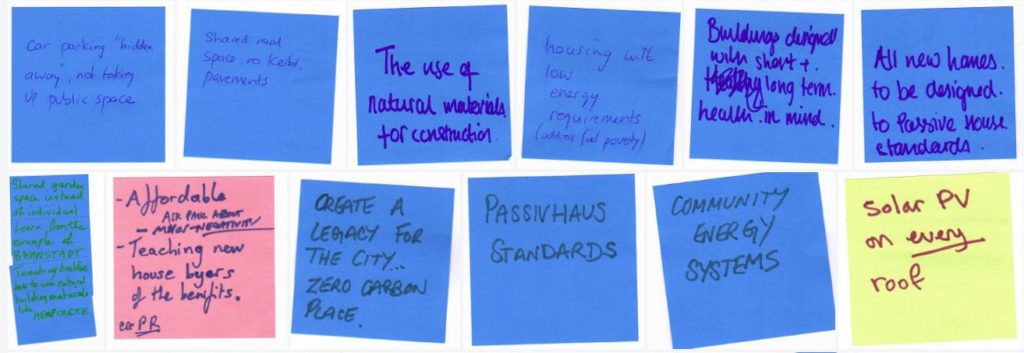
A brief report and some links from the evening
The Sustainable Construction evening – like most My York Central events – had a varied audience which included interested local residents, students, council officers plus one Passivhaus client and one Passivhaus Designer. We had three presentations, each followed by a Q&A session, and then a chance for people to list – on the basis of what they’d heard – three things they’d like to see happen on York Central. The results of this – in the form, obviously, of Post-Its, are here.
Chris Thompson from Citu talked us through their journey from conventional approach to housebuilding through their Kelham Island development in Sheffield to Leeds South Bank – a journey into high-quality, off-site-manufactured construction driven by a desire for efficiency; the best of the UK conventional construction industry is about 40% efficient in use of resources, so there are gains to be made. The South Bank development will double the size of Leeds City Centre over 20-30 years, and Citu are building around 750 homes across two phases (York Central will have between 1700-2500 homes, for comparison). In addition to being the first new homes in the city centre for about 90 years, Citu are building family homes – and also working with a local provider to build a primary school to serve this new demand. Key points are that all freehold and energy assets (PV arrays and distribution) are owned by a Community Interest Company. If this all sounds too edgy to sell, well – they had buyers camping overnight outside their sales office before it opened. Chris’ presentation is here.
Rachel Trend from Native Architects talked through the work of the practice and, importantly, their willingness to put their money (and their staff) where their mouth is – with use of natural materials in renovation of their own office (work carried out by themselves) and a number of very fine buildings for practice members and key clients. Strawbale – both loadbearing and the Modcell modular system (as used by Lilac in Leeds) featured, and Hempcrete (hand-tamped, sprayed and pre-cast), plus timber and rammed earth. Rachel made it clear that natural building materials often punch above their weight by performing better in real-world use than other more apparently-sophisticated alternatives. Her excellent presentation is here.
Phil Bixby is an architect and Passivhaus Designer based in York, and he ran through what makes a Passivhaus different, what benefits this approach to construction brings, and specifically how the Passivhaus standard makes a good launch pad to go to zero-carbon construction. Data from recent completed schemes shows how households can generate more energy than they use, and how even electric car ownership needn’t tax the grid if homes are designed for solar from the start. Phil’s presentation is here.
Take a look through the Post-Its to draw your own conclusions on people’s priorities, but there was a clear feeling that we should be bold, and create a new part of the city which used sustainable technologies – of all sorts – to create a place where anyone would want to live and work.